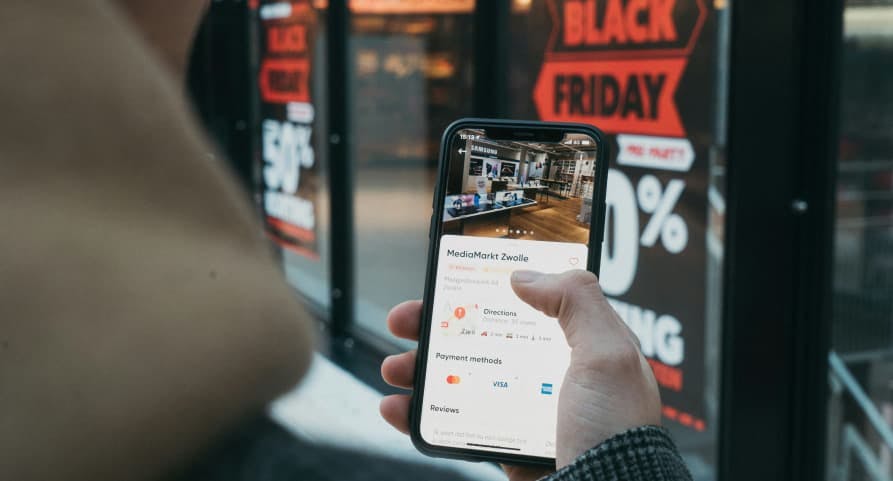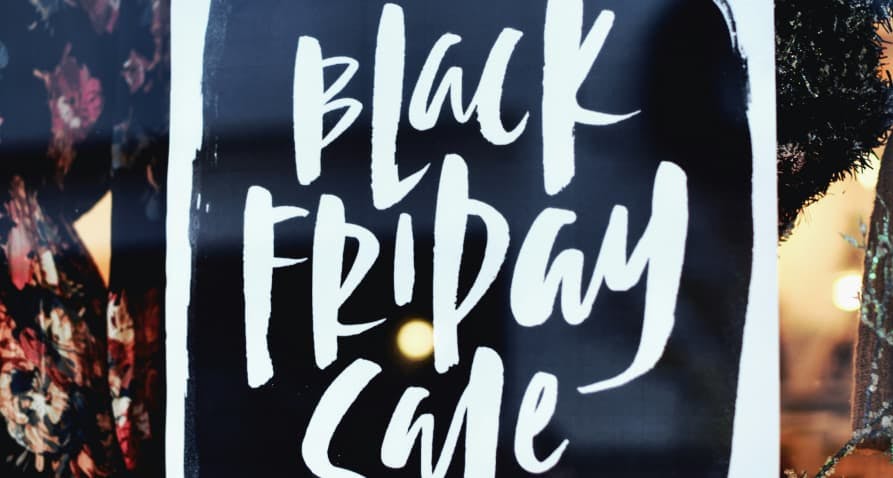
Sustainable Development Goals (SDGs): All You Need to Know
The United Nations has defined 17 goals, aimed at creating a better world. What are these so-called "Sustainable Development Goals" ? Explanations.
ESG / CSR
Industries



Black Friday used to be more of a fun tradition than about shopping for deals, with people waking up in the early hours of the morning to scour the mall for the best deals possible – but the history of Black Friday and how it has evolved to what it is today is a direct result of excessive consumerism.
Following the pandemic, people started to shop for Black Friday as if it were Cyber Monday – encouraging even easier purchases to be made and eradicating the original traditions associated with Black Friday.
In this article, we’ll discuss the history of Black Friday, how it evolved to what it is today, and how to make your shopping habits more eco-friendly with Green Friday.
Black Friday refers to the Friday after Thanksgiving in the United States, which is always the last Thursday in November – making Black Friday the last Friday in November, and is an American tradition where retailers offer goods and services at extremely discounted prices.
💡 Black Friday usually marks the end of autumn in the United States, and the first day where people transition their homes to Christmas and start their holiday shopping.
Here are some characteristics of Black Friday:
💡 Regardless, Black Friday remains one of the busiest times of year for shopping – with Black Friday sales reaching $9.5 billion USD in 2023 alone.
👉 Overall, Black Friday is an annual shopping event driven by the lure of extreme discounts, and continues to evolve each year to accommodate changing retail habits – such as how more people are shopping leisurely online.

Black Friday wasn’t always a day for shopping, as the term was originally used to describe “darker days” – such as when the gold market collapsed in 1869. Ultimately, the Black Friday we have come to know today, centralized around capitalism and consumerism – was not coined until the 1950s.
💡 For instance, the term “Black Friday” was first used when investors Jay Gould and James Fisk that had an investment that failed on September 24th, 1869 – and was called Black Friday to characterize the collapse of the gold market and the unfathomable amount of money lost.
The meaning behind “Black Friday” is often attributed to when retail stores got out of “the red” and into “the black”.
“In the red” refers to a business that is losing money or operating in a deficit, whereas “in the black” describes a business operating from a place of positive cash flow – where profits are fruitful and opportunities to expand the business are prevalent.
💡 However, the name “Black Friday” came to be as a result of a football game in Philadelphia in the 1960's. During this football game, there was a large surge of people traveling into Philadelphia – where many people went shopping on their day off.
The earliest example of Black Friday was first depicted in a trade journal, Factory Management & Maintenance, published in 1951 where researcher Bonnie Taylor-Blake referred to Black Friday as the day after Thanksgiving.
💡 However, this first reference to Black Friday had nothing to do with shopping, but how people wouldn’t come to work for the Friday after – as Black Friday is not a day off in the United States, and it was proving increasingly difficult to get factory workers to show up after Thanksgiving.
Furthermore, police officers in Philadelphia started to refer to Black Friday as a day of doom, as there was too much traffic with suburban residents traveling to the city to go shopping on the makeshift holiday weekend.
Heading into the 1950s and the 1960s, retailers tried to rebrand it as “Big Friday” – as there was an ongoing myth that illustrated retail stores going, “in the black” – illustrating a business that is earning more than it is spending, and paints the business in a positive light as lucrative and desirable.
👉 Ultimately, it’s hard to decipher when the first official Black Friday shopping day was – as the history of Black Friday developed over time to become the infamous day of discounts it is now.

Although the history of Black Friday is eventful, the actual Friday after Thanksgiving is often a lull for most Americans – with many people taking off work and staying at home to spend more time with their families.
💡 Albeit Black Friday being depicted as a day of chaos in the media, it is usually the exact opposite for Americans – with many opting to travel home early to avoid crowds or simply picking at Thanksgiving leftovers from the fridge.
Cyber Monday is an online shopping event that occurs the Monday after Thanksgiving, and serves as a digital follow-up to Black Friday. Having started in 2005, Cyber Monday allows people to shop for these discounts from the comfort of their own home.
Today, Cyber Monday is now a global endeavor – and remains as one of the biggest online shopping days of the year. As a result, retailers often extend Cyber Monday into Cyber Week – where they allow customers to purchase goods and services at a discounted price the entire week before or after Thanksgiving to attract holiday shoppers.
💡 As e-commerce continues to grow, Black Friday shopping will continue to move online – especially as Black Friday influences other countries to enact these substantial holiday sales.
However, what remains concerning about Cyber Monday in terms of the environment is that it allows people to easily purchase items they may not need – leading to waste in our landfills and encouraging excess consumerism.
The table below will further demonstrate the differences between the early days and history of Black Friday shopping, Cyber Monday, and post-pandemic shopping trends:
| Aspect | Black Friday Shopping (Before the Internet) | Cyber Monday & Post-Pandemic Shopping Trends |
|---|---|---|
| Shopping Location | Primarily in-store shopping, with people visiting malls and retail stores for deals. | Mostly online shopping, with retailers focusing on e-commerce platforms and mobile apps. |
| Shopping Duration | One-day event, taking place on the Friday after Thanksgiving. | Extended duration; sales often start on Thanksgiving, continue through Cyber Monday, and can last into "Cyber Week." |
| Customer Experience | High energy, in-person experience with crowded stores and long lines. Doorbuster deals were common. | Convenient, at-home shopping with a focus on website navigation, fast shipping, and digital customer service. |
| Types of Deals | Primarily in-store exclusive deals with limited quantities. Discounts were focused on electronics, toys, and seasonal items. | Wider range of deals across various categories, with exclusive online discounts and flash sales on electronics, clothing, and more. |
| Environmental Impact | Focused on physical retail, which generated waste from packaging, transportation, and in-store crowd control. | Increase in shipping and packaging waste, but with growing emphasis on sustainable practices, such as eco-friendly packaging. |
| Shopping Trends Post-Pandemic | Pre-internet Black Friday was exclusively in-store; online shopping was not a factor. | Post-pandemic, there is a stronger shift towards online shopping, with many consumers prioritizing convenience, safety, and flexibility. |
| Focus on Safety and Health | Little emphasis on health and safety, aside from basic crowd management. | Enhanced health and safety measures due to the pandemic, with options for curbside pickup, contactless delivery, and remote shopping. |
👉 Following the birth and growth of Cyber Week, it is more than likely that we have seen the last of in-person, fanatic Black Friday shopping – and when we tell the next generation about the history of Black Friday, they will think we are crazy for waking up that early to shop – especially as thousands of malls across the country continue to close.

At Greenly, we are taking initiative to promote the importance of “Green Friday” – as Black Friday traditionally contributes to over 1.2 million carbon dioxide emissions every year.
💡”Green Friday” is an effort on behalf of U.S. marketing to discuss how typical Black Friday traditions impact the environment, providing an outlet for people to brainstorm ideas to decarbonize their shopping habits.
Here are some ways we can go green on Black Friday and promote the importance of “Green Friday”:

👉 Show us your “Green Friday” traditions this year using the hashtags #GreenFriday #Greenly!
Overall, there are countless ways to promote the importance of sustainability on “Green Friday” in place of Black Friday’s more traditional shopping tendencies – and if you're not sure how to get your company started, Greenly is always here to help.
If reading this article about the history of Black Friday and how to go green has made you interested in reducing your carbon emissions to further fight against climate change – Greenly can help you!
It can be overwhelming to figure out how to effectively reduce your environmental impact when shopping, but don’t worry – Greenly is here to help. Click here to schedule a demo to see how Greenly can help you find ways to ensure your company is complying with all current and future environmental regulations.
Greenly can help you make an environmental change for the better, starting with a carbon footprint assessment to know how much carbon emissions your company produces.
